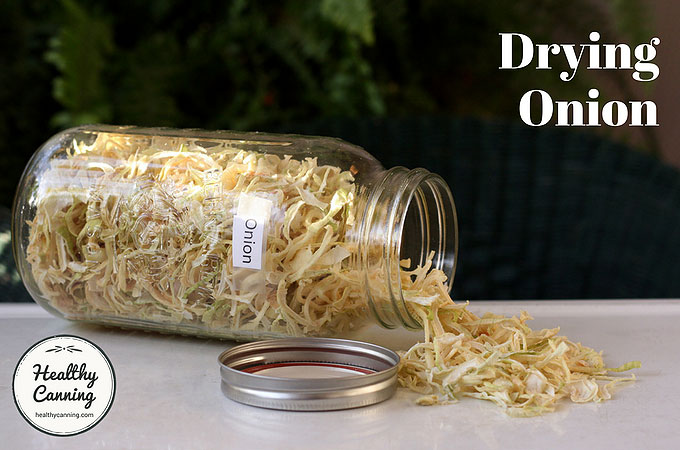Onions are one of easiest things to dry, and yield one of the highest quality dried products to boot. So it’s no surprise that they’re also one of the foods most commonly dried.
Dehydrate in a well-ventilated area (or away from where you are) if possible, as the “aroma” can be eye-watering. Some people even keep a separate dehydrator for drying onions and garlic.
See also: Drying Leeks, Onion Powder
Yields and Equivalents
- 1 medium fresh onion = 1 cup (150 g / 5 oz) fresh = ¼ cup (30 g / 1 oz) dried minced onion = 1 ½ tablespoons onion powder [1]So Easy to Preserve, 2014, page 364
- 20 lbs (9.1 kg) of peeled onion will dry down to 3 lbs (1.3 kg) [2]Ball Blue Book, 2014, page 163.
- 1 cup dried onion = 120 g / 4 oz
- 1 x 10 lb (4.5 kg) bag of fresh onion, unpeeled = 9 standard Excalibur trays of fresh onion, peeled and sliced = 12 cups dried onion slices = 4 ½ cups (400 g) minced onion
Directions
Here we compare directions from three different sources.
Note the wide range of suggested drying temperatures.
Ball Blue Book
Preparation: Trim ends off onions, peel off paper shell, cut into slices ¼ inch (5 mm) thick.
Blanching: None
Temperature: 145 F / 62 C (sic)
Time: Until crisp.
Notes: “Choose red, white, or yellow onions; white varieties dry best.”
Water content: 89%. (Used if doing a Dehydration Weight Test.)
Reference: Ball Blue Book, 37th edition, 2014. Page 167.
Notes: In the Ball All New, they suggest slicing or dicing. The suggested drying temperature is lower: 125 F / 52 C. [3]2016 edition, page 339.
Excalibur
Preparation: “Remove the root and top, and peel off the paper shell. Cut the onion into ¼″ (5 mm) slices or ⅛″ (2 to 3 mm) rings or chop it. No pretreatment is required.”
Blanching: None.
Temperature: 155 F / 68 C
Time: “Until leathery.” Time estimate is 4 to 8 hours, depending on humidity in your area.
Quality: Excellent
Notes: “Onions are excellent when dehydrated, particularly varieties such as White Bermuda, Red Creole, Downing Yellow Globe, Southport White Globe, Southport Red Globe, Sweet Spanish, and White Creole. Onions should be heavy for their size and have a pungent taste and aroma. Because of this odour, however, avoid drying them with other vegetables.”
Reference: Excalibur. Preserve it naturally. 4th edition, 2012. Page 26 and 56.
So Easy To Preserve
Preparation: “Wash, remove outer ‘paper shells.’ Remove tops and root ends, slice ⅛ to ¼ inch thick.”
Blanching: None
Temperature: 140 F / 60 C
Time: 3 to 9 hours.
Quality: Good to excellent
Reference: So Easy To Preserve. 6th Edition. 2014. Page 350.

Onions on drying tray
Notes
To reduce drying time and for more even results and better quality, when feasible, rotate trays 90 degrees every hour or so, or, rotate them 180 degrees halfway through drying,
A mandolin or food processor can be ideal for evenly cut slices.
It’s okay if they touch a bit on the trays, as the pieces will shrink away from each other as they dry, but don’t heap them on in layers.
If you prepped more than you have the trays for at one time, store the onion in a well-sealed container in the fridge for up to 3 days, and dry as dehydrator tray space becomes available.
Storage
Let the dehydrated product cool completely to room temperature before packing it into storage containers.
Watch the sealed containers for the first few days for any sign of condensation. If condensation occurs, dehydrate a bit more.
Label jar with name of product and date. Store away from heat and direct light.
Usage notes
Use dried onion as seasoning in dishes.
To rehydrate, to each 1 cup dried onion pieces add 2 cups (500 ml / 16 oz) boiling water. Let stand for a minimum of ¾ hour. [4]SETP, 2014, page 363 The rehydrating water has excellent flavour for use as a cooking liquid in other dishes.
When using in recipes such as soups or stews that have a lot of liquid in them and are long cooking, many people say they just toss the dried onion directly in. However, for drier recipes, you’ll certainly always want to rehydrate first for sure.
You can also use your food processor to chop the dried onion pieces into onion flakes, or a mill to grind it into onion powder.
References



R
When dehydrating; how many pounds (weight) of fresh onions do I have to start with to get one pound of dried onions?
Volume measurements do not count, because producers of dried onions sell them by the pound.
This is important when calculating the cost comparison to dry onions that you do not grow yourself; verses the price buying a container of dried onions.
chris
I’d like to know this answer myself. How many pounds of onions to get 1lb of dried?
Karen
should the onions be crispy, or leatherly?
Healthy Canning
Speaking from bitter experience, aim for leathery. If you aim for crispy, you risk the sugars in the onions burning and going bitter from excessive heat exposure.
Karen
thank you. I will do that.
kimmy
how do you keep onions white.mine turn brown before they are done…
Healthy Canning
If the heat in a dehydrator is too high, it can cause them to carmelize. I had that problem when I started with a less expensive dehydrator that didn’t allow temperature control. Browning may also depend on the exactly variety of onion being dried: how much sugar content it has.